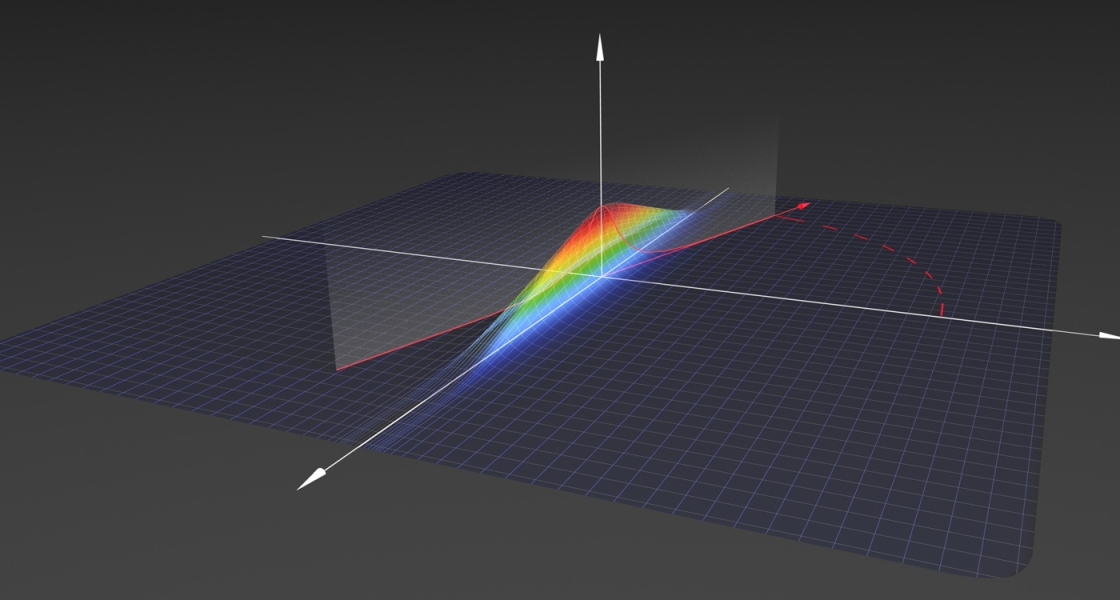The Lehnert group and collaborators from the National Institute of Standards and Technology (NIST) recently made what was essentially a CT scan of the quantum state of a microwave field. The researchers made 100 measurements at different angles of this quantum state as it was wiggling around. Because they only viewed the quantum state from one angle at a time, they were able to circumvent quantum uncertainties to make virtually noiseless measurements of amplitude changes in their tiny microwave signals. Multiple precision measurements of the same quantum state yielded a full quantum picture of the microwave field.
“What we did was a quantum version of the CT scan for light at microwave frequencies,” says Lehnert. “Since we can represent information as a state of a microwave field, this is a lively topic in the field of quantum information processing.” Lehnert adds that measuring microwave fields (and manipulating information with them) already works fairly well with microwaves trapped inside a box, or cavity. However, the Lehnert group and its NIST collaborators have taken the plunge of measuring a single quantum state outside the box.
The JILA team includes research associate François Mallet, graduate student Hsiang-Sheng Ku, former graduate student Manuel Castellanos-Beltran and Fellow Konrad Lehnert. Their NIST-Boulder collaborators include Scott Glancy, Emanuel Knill, Kent Irwin, Gene Hilton, and Leila Vale. The eventual goal of the joint research is the creation of quantum entanglement of different quantum states of a microwave field outside of a cavity. Quantum entanglement is a kind of spooky shared quantum state (superposition) that extends across space and time. It is an essential ingredient for high-speed quantum computing.
The key ingredient in creating quantum entanglement as well as in measuring the quantum state of a microwave field is a Josephson parametric amplifier, or JPA. The best-ever design of such a device was created in 2008 by the JILA/NIST collaboration. This JPA not only functioned as a virtually noiseless amplifier (See JILA Light & Matter, Fall 2008), but also had ability to squeeze most of the quantum fluctuations (wiggles) out of one of the two directions of a coordinate system.
In their recent experiment, the researchers used one JPA as a preamplifier to improve the quantum efficiency of their measurement from 2 to 36% and the other to squeeze the microwave field. In the squeezed direction, the measured field change was as low as 40% of the amount of quantum fluctuation that normally occurs in a vacuum. In other words, this JPA works better in one direction than even Mother Nature does. The result of all this quantum precision is a full tomographic image of a single state of a microwave field.
With results like these, the collaboration is ready to explore what happens when they use four JPAs to create two microwave squeezed states at the same time and then combine the squeezed states in a beam splitter. The researchers are already beginning to imagine the creation of millions of bits of entanglement every second. At this rate, the new quantum CT scan could soon seem like child’s play.



 The Physics Frontiers Centers (PFC) program supports university-based centers and institutes where the collective efforts of a larger group of individuals can enable transformational advances in the most promising research areas. The program is designed to foster major breakthroughs at the intellectual frontiers of physics by providing needed resources such as combinations of talents, skills, disciplines, and/or specialized infrastructure, not usually available to individual investigators or small groups, in an environment in which the collective efforts of the larger group can be shown to be seminal to promoting significant progress in the science and the education of students. PFCs also include creative, substantive activities aimed at enhancing education, broadening participation of traditionally underrepresented groups, and outreach to the scientific community and general public.
The Physics Frontiers Centers (PFC) program supports university-based centers and institutes where the collective efforts of a larger group of individuals can enable transformational advances in the most promising research areas. The program is designed to foster major breakthroughs at the intellectual frontiers of physics by providing needed resources such as combinations of talents, skills, disciplines, and/or specialized infrastructure, not usually available to individual investigators or small groups, in an environment in which the collective efforts of the larger group can be shown to be seminal to promoting significant progress in the science and the education of students. PFCs also include creative, substantive activities aimed at enhancing education, broadening participation of traditionally underrepresented groups, and outreach to the scientific community and general public.